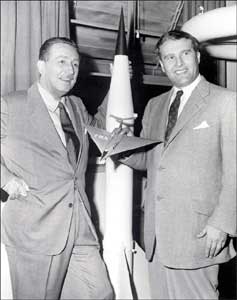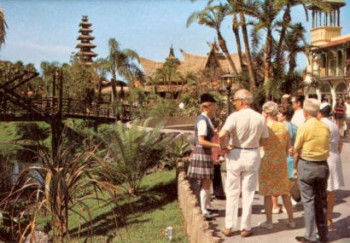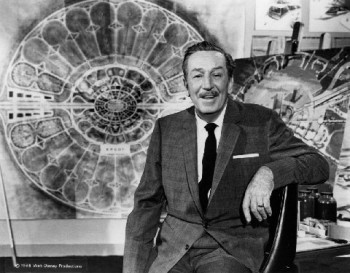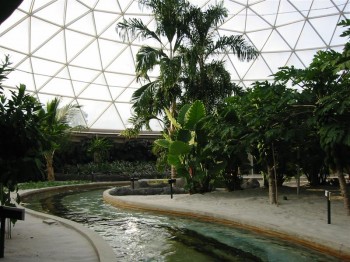Foxx at Passport to Dreams Old & New has written an interesting series of articles entitled “For Further Study”, the latest of which surveys Frontierland’s Rivers of America for references to the works of Mark Twain. The series aims to direct readers to the vast well of history, literature and culture that informed and inspired the original Imagineers who created the Disney parks, finding surprising linkages to fairly obscure works. Such analysis is especially fruitful in the original Magic Kingdoms, as they tend to be more filled with the type of detail and references drawn from our collective past rather than the latest marketing-friendly film franchises.
Ray Bradbury once called Imagineering a “renaissance organization”, and that’s far from hyperbole. While Disneyana has rarely been considered high culture, those who have studied the organization and its creations know the diversity of sources from which they draw. The creative team that Walt Disney assembled over the years, first in animation and later in Imagineering, were an eclectic and talented lot, with a vast range of expertise – many of them truly were renaissance men and women. Disney himself had no formal education, yet still seemed well-read in Americana and intensely curious about several fields of study. Ironically, while Disney seems to have been averse to academia and its trappings himself, his passion for finding good stories and new technology always seemed to involve him in research of some sort.
This diversity of inspiration can been seen in something as elementary as the layout of Walt’s own theme park – a conceit mirrored in the opening of the Disneyland television show:
The program, as well as the park it was designed to promote, was divided into different cardinal realms. Frontierland contained “tall tales and true from the legendary past.” Tomorrowland represented the “promise of things to come,” while Adventureland promised to whisk one away to “the wonder-world of nature’s own realm.” Note that only Fantasyland, “the happiest kingdom of them all”, represented a departure from reality – even Frontierland’s “tall tales” were based in historical truth.
Every week, the Disneyland program would feature a story from one of these lands, and when Disneyland park opened it gave guests the opportunity to experience the worlds that they had seen on television. For Walt, this represented an opportunity to share stories that, aside from being simply good yarns, he felt were important and informative of the American experience. It also allowed him to use the talents of his artists to spread ideas and information he thought important – something he had been doing since he personally financed 1943’s Victory Through Air Power in order to promote the ideas of Alexander de Seversky. The Disneyland show provided a mix of nature programming, futurism and fictionalized tales of historical heroes. Against this creative background, Disneyland and Walt Disney World were conceived.
 Disney and Werner von Braun, consultant on the Tomorrowland-based Disneyland episodes. It’s said that these episodes were used to help convince President Eisenhower to pursue the beginnings of the American space program.
Disney and Werner von Braun, consultant on the Tomorrowland-based Disneyland episodes. It’s said that these episodes were used to help convince President Eisenhower to pursue the beginnings of the American space program.The Magic Kingdom is peppered with these details, from the aforementioned Twain influences to name-drops of Texas John Slaughter and Johnny Tremain. The Tomorrowlands of 1955, 1959, 1967 and 1971 were designed from a real-world scientific standpoint. But while Disney often looked to mine American history and literature for inspiration, modern Disney management is far more focused on the current franchise du jour and subsequent marketing tie-ins. Without this eye towards the past, as well as the desire to incorporate ideas from diverse fields of study, I fear that the future Disney experience will inspire no further study than popping the latest animated release into the DVD player.
This might seem like an obscure and, to some, ridiculous concern, but it comes from some personal experience. I was fortunate enough to be indoctrinated to Disneyana at such an age that much of my exposure to many new ideas and concepts came through Disney. I was first exposed to everything from Dixieland jazz to linear induction motors through Disney films and parks. EPCOT Center provided an especially fruitful source of information, introducing me to solar cells, touch screens, fiber optics, Albert Robidia, DNA, and dozens of other things, including the cultures of eleven countries. Every time I see tilapia being served in a restaurant, I think of the Land.
This is not to say that Disney should even remotely be considered the beginning and end of any course of study; rather, than these introductions and allusions to concepts in such an entertaining and exciting setting helped ingrain them into my young mind and thus provided an excellent jumping-off point of any number of fields. Walt had it right – leaven the entertainment with enough actual information and you can spread ideas that otherwise would be dry or unapproachable. The melange of concepts and inspiration that combined to form those original Disney parks provided the seeds for a later love of aesthetics as diverse as Victorian futurism, steampunk, Tiki culture, art deco, and populuxe, as well as fields of study from urban planning to the Old West to space exploration.
When I rail against the creep of marketing tie-ins or the “toonification” of Tomorrowland, it’s this diversity of inspiration that I fear losing. Looking at the opening day roster of attractions at Florida’s Magic Kingdom, the only attraction based on a fictional film property outside of Fantasyland was the Swiss Family Robinson treehouse. Frontierland had it’s Davy Crockett-based canoes and keel boats, but those at least had some historical basis. Everything else was based on some form of original property (Tropical Serenade, The Country Bear Jamboree), true-life adventure (the Jungle Cruise) or history itself (the Hall of Presidents). It was not until the latter day when cartoon fantasy began to make its way into Adventureland and Tomorrowland.
 Adventureland, 1971. Not a toon in sight. (Photo from Widen Your World)
Adventureland, 1971. Not a toon in sight. (Photo from Widen Your World)The slew of unsubstantiated rumors that have so far emerged for the as yet unannounced Shanghai Disneyland only point to a continuation of this trend. Every rumor brings a new twist – a Tomorrowland themed to WALL-E, a Frontierland centered on Toy Story characters, and the possible re-creation of California Adventure’s “Cars Land” have all been mentioned in various online sources. Disney fans have often lamented that the possibility of a new non-franchise based attraction like the original Pirates of the Caribbean or Haunted Mansion is extremely unlikely these days, but until I started thinking about “For Further Study” I hadn’t really considered why the idea was so disturbing.
It’s hard to conceive of the modern Walt Disney Company building something as shockingly innovative and high-concept as Spaceship Earth or Horizons anymore. The aspiration to inform and inspire seems lost, save for possibly Joe Rhode’s work at Animal Kingdom. It seems equally unlikely that anyone at WDC is interested in mining the corpus of American history and literature for inspiration, making something as simple as Frontierland’s Twain references fairly unlikely. Compare California Adventure’s Golden Dreams to the American Adventure – as whitewashed as the EPCOT attraction might be, it’s far more complex that its descendants.

As the American Adventure itself says, the golden age was never the present. It’s human nature to look fondly at the past and to be, at least slightly, suspicious of change. Many Disney traditionalists are accused of such blinded conservatism. But the thematic change in the stateside Disney parks has been noticeable even in the last decade, and the creep of franchise-driven entertainment and “toonification” of formerly “true-life” lands has eroded the interest of those of us who find our actual history and the real world we live in as fascinating as the latest tent-pole blockbuster. If we allow our interests to get so narrow – so synergistic – eventually all Disney will inspire for further study is more Disney. It would become an insular world, drawing from nothing and leading to nothing. That would be a loss for everyone.










“It would become an insular world, drawing from nothing and leading to nothing.” Sounds like the last 8 years in this country.
In the panic to give families something they recognize in an attraction (a la Toy Story Midway Mania or The Seas with Nemo and Friends), they forget that it was Disney who introduced us to the small world, Pirates of the Caribbean, and the Grim Grinning Ghosts. And although they are now part of the cultural lexicon, this was not the case before these groundbreaking attractions opened.
The Tomorrowland of my youth was bright, not including neon, and had clean lines gliding towards the sky and was filled with attractions that made you think or want to try something new. The only attraction in the current incarnation of Tomorrowland that even holds a glimmer of that golden age of the future is, surprise surprise, the Carrousel of Progress. The same goes for Future World, where its sounds, colors, and ideas sparked numerous journey’s of my imagination. My parents could, off the top their heads, speak on how many times I wanted to live in a colony in space or better yet help build it or the times when I became interested in our own history, my mom’s garden, or my father’s work in the field of transportation.
To the Imagineers credit, the work of Joe Rohde has been a bright spot in the storm, as have attractions like Soarin’, but that is a very short list. I do hope that the day is coming soon where we once again see some amazing and marvelous new ideas, but with the current climate of theme park competition to find that next big recognizable property (the Wizarding World of Harry Potter), I think that we have a long wait coming.
This is awesome. ^^ I love when my writing causes good writing to appear. XD
Very nicely put, a nice interpretation as to legitimate concern with ‘toonification’. Although, let me play devil’s advocate for a second:
“When I rail against the creep of marketing tie-ins or the “toonification” of Tomorrowland, it’s this diversity of inspiration that I fear losing.”
While I agree with this to an extent, doesn’t this go against what you were saying earlier? What do you think of the vintage educational shorts starring characters (such as Scrooge McDuck’s short on the basics of money or Donald in Mathimagicland?). Why is it that Disney can take other’s popular culture and use it to entertain and inform, but can’t do it with their own IP? A decent example of this is the makeover of El Rio Del Tiempo. Still gets across the information about Mexico (for the most part,) but amps up the entertainment factor significantly. The Seas w/ Nemo attempts to do the same thing. I miss my retro-future Sea Base Alpha, but the new overlay does a much better job at educating and engaging most children.
And here is another thought. The majority of things you were talking about arose out of different historical contexts. EPCOT is what it is because they were miming the idea of a world’s fair and the celebration of industry. The narrative it told was a result of this goal, not out of an all encompassing plan to improve the world. For all its positive message, EPCOT was still a commercial, corporate undertaking, meant to generate income more than anything else.
Animal Kingdom, and also MGM/DHS, continue the learning through osmosis Foxx talks about with Mark Twain. How about the victory garden behind Rosie’s? Or the soon to be gone studio tour? And pretty much the entirety of AK can be cited – and don’t be too sure that it can all be attributed to just Joe Rhode. He is a marvelous imagineer, but putting so much credit on one man when this is clearly a collaborative ‘art’ does a disservice to all of other dreamers that work under the radar.
I love Disney, and I must admit that for me it is the combination of both the academic and the sensational (not that these are necessarily mutually exclusive) that draws me in and keeps me wanting more. I love the cultural lessons I get while wandering through the countries in EPCOT, but I also enjoy the pure thrill of Test Track (although as far as I am concerned they could upgrade the pre-show now that I’ve seen it a hundred times.) I miss the educational type experiences that were possible with World of Motion, Horizons, Wonders of Life, etc. I also agree with Ryan about Tomorrowland, and although I am happy to still have it at all, I do miss the pristine whites and futuristic look of the place that I first knew and loved. The spiraling, spinning spheres (wow, how about that alliteration!) could go away, and I’d never miss them. IMO, the mere fact of the influence of Werner Von Braun, for goodness sake, should have been enough to keep some of the original look in Tomorrowland. I am, however, thankful that we have many books and even video to look at and remember the way things were.
Disney is truly as much about sentimentality and reminiscence, for me, as present experience. And I would venture to say that would be the case for most true Disney fans. And as much as they may think it necessary to aim their marketing at the very young, maybe one day Disney will wake up and realize that the people holding the pocketbooks (i.e. parents, grandparents) are the ones who come back to the parks and original movies time after time to recapture something that they first fell in love with as young people. I have no problem with occasional additions to the old favorites, but we “Generation-whatevers” need to be able to connect to our past (at least I do.) For me, that means Horizons, World of Motion, If I Had Wings, Mr. Toad’s Wild Ride, etc.
Back to your point, though, I believe it was Walt’s desire that we be able to have fun while experiencing the amazing things history, science, culture, etc. have to offer. And I don’t think he saw the necessity to toonify things (not that there’s anything wrong with toons, mind you.) But I think it’s precisely the fact that it remains largely un-toonified that we (my family of 5) tend to spend most of our time at WDW wandering the amazing pavilions at EPCOT.
Just my 2 cents (okay, maybe ten dollars) worth,
Christi